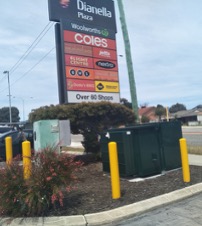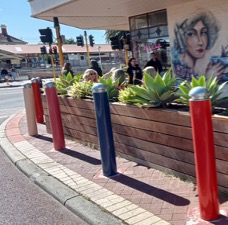Enhancing Safety with Modern Bollard Solutions
- Smart Urban

- Aug 12
- 4 min read
Updated: Sep 10
As urban areas grow, so do the challenges of maintaining safety, accessibility, and aesthetics. One of the key elements in achieving this balance is the effective use of modern urban bollard solutions. These structures, often overlooked, play a vital role in urban design by protecting pedestrians, preventing unauthorized vehicular access, and enhancing overall safety.

Urban Bollard Solutions
Urban bollards are safety posts placed at strategic points in cityscapes to manage traffic flow and enhance public safety. They serve multiple purposes, including preventing vehicle access to pedestrian zones, protecting public spaces, and guiding traffic.
When assessing the effectiveness of various bollard solutions, it is crucial to consider their design, longivity of the materials, ability to withstand impact, and on-going maintenance costs. For instance, new age advanced polymer bollards, impact resistant, and impact recovery bollard technologies are now being used to improve safety and substantially reduce long term maintenance
Research shows that bollards can significantly reduce the risk of vehicle-related accidents. According to the National Highway Traffic Safety Administration (NHTSA), improving urban infrastructure could lower pedestrian fatalities by up to 50%. Bollards are not merely functional; they contribute to creating safer and more functional urban environments.
The Importance of Bollard Solutions
Bollard solutions are incredibly important for enhancing safety in urban settings. They can protect assets and pedestrians in busy areas, create designated walkways, and help control vehicle speed. For instance, City of Perth and Fremantle have implemented ZERO WASTE bollard solutions to ensure the safety of pedestrians in high-traffic zones.
Statistics reveal that urban pedestrian injuries have decreased by over 30% in areas where effective bollard solutions have been applied.
When considering the installation of bollards, local governments and urban planners should take into account factors such as visibility, safety features and maintenance costs. By choosing the right type of bollards, cities can achieve a safer atmosphere while greatly improving efficiency and reducing on-going costs.
Bollards are subject to impact
When impacted something’s got to give! So, unless you incorporate some form of shock absorbing mechanism the bollard and footing will need replacing every time. Traditionally bollards were installed directly inground or surface mounted, but there is never a good outcome, as both the bollard and the footings need replacing every time!
All this work is creating tonnes of unnecessary concrete waste and lining the pockets of the suppliers at your expense. Some companies sell flexible bollards that are either made of soft old fashioned plastic or are spring loaded (over-flexing causing dangerous litigation risks and offering very little, if any protection as spring wear out after mutiple impacts and often breaking upon high impact)

Surface Mount Bollards: When a surface mount bollard is impacted, if the bollard itself is strong enough- the impact force is directed to the base plate, which bends or is ripped from the concrete.
Inground Bollards: When a bollard installed directly in concrete is impacted, if the bollard itself is strong enough to withstand the impact force, it is then directed to the footing, which is dislodged
Poor quality Bollard Casing: Another growing problem is caused by cheap imported bollards made from light walled inferior grade steel or stainless steel and simply crumple upon impact or rust out creating even more landfill.

City of Perth came to us to develop a solution that would provide protection, reduce damage to vehicles and reduce the cost of maintenace- We developed the Impact Recovery System that provides a low cost and sustainable solution to all of these problems.
This question is often raised in discussions about urban safety: Can a bollard actually stop a car? The answer largely depends on the type of bollard and its installation. There is currently only one crash-rated bollard that has been approved and can stop a vehicle traveling at speeds up to 50 mph. The Energy Absorbing Bollard.

Types of Modern Bollard Solutions
Different types of bollard solutions serve unique functions, each designed to meet specific urban safety needs. Below are some of the most common types of modern bollards:
Advanced Polymer Non-conductive Bollards and Bollard Covers are made from a highly advanced polyethylene blend that is resistant to impact and has a lifespan of up to 50 years. We won't rust or scratch (same colour throughout) won't dent vehicles and can be secured using the Impact Recovery System (see below) making both the bollard and footings re-usable following even severe impact
Removable pedestrian and traffic Bollards are low cost bollards that are secured on ZERO WASTE Foundationsd making them easily removable and extremely low cost to maintain- will never become locked in socket and can be replaced in literally seconds- you will see them along the freeways in WA.
Impact Recovery Bollards are bollards (steel, stainless steel or Advanced Polymer) secured using an impact absorbing cushion that won't wear out following mutliple imapcts (hundreds of impacts) making bollards deflect up to 20 degrees and self recover. A strong resistance core prevents deflection beyond 20 degrees and if badly impacted the bollard and footings are removable and re-usable. Both Surface Mount & In-ground design available.
The Future of Urban Safety
Innovations in smart city planning are leading to the development of intelligent bollards equipped with sensors and connectivity features. These smart bollards can provide real-time data on pedestrian traffic, alert city planners to potential safety hazards, or even facilitate intelligent traffic management by controlling access during peak hours.
This kind of proactive approach allows for greater adaptability and more comprehensive safety strategies. Moreover, the integration of solar panels into bollard designs is becoming more common. Solar-powered lighting within bollards can enhance visibility at night, further improving pedestrian safety. Our Advanced Polymer Bollards can be made to "glow at night" greatly improving the safety of dark roads and dangerous corners on country roads











Comments